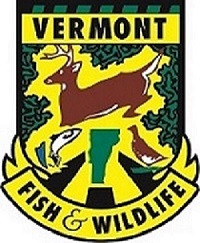
Vermont Fish and Wildlife Department staff met with members of The Nature Conservancy, Vermont Agency of Agriculture, Food and Markets, Vermont Housing & Conservation Board and Senator Patrick Leahy’s office on September 21 to celebrate the recent acquisition and conservation of an important wetland property along the Winooski River on the Burlington-Colchester town line by planting 25 disease-resistant elm trees to begin to restore the site to its natural floodplain habitat.
The gathering recognized the unique partnerships that played a key role in conserving the property for habitat restoration and providing opportunities for wildlife-based recreation in the Greater Burlington Area.
“This property is an integral piece of a larger wetland complex, locally known as the Intervale,” said Fish and Wildlife’s waterfowl biologist David Sausville. “These wetlands provide optimal habitat for nesting waterfowl, wading birds, shore birds, and other bird species. They buffer against flooding and reduce sediment and nutrient deposition into Lake Champlain. They also provide public-use value through hunting, angling and other forms of wildlife-based recreation.”
Situated in the floodplain of the Lower Winooski River, the 144-acre former Fitzgerald farm property at the end of Pine Island Road has historically been challenging to farm due to seasonal and intermittent flooding. Faced with additional pressures including costs to upgrade farm infrastructure, proximity to the Winooski River, and the changing agricultural economy, the farm was identified for retirement and ultimately floodplain and wetland restoration.
“This is a bittersweet day for me,” said Ben Gabos, Conservation Reserve Enhancement Program Coordinator for the Vermont Agency of Agriculture, Food and Markets. “Yes, retiring this farm and restoring it to floodplain forest and wetlands will significantly enhance the land’s ability to store floodwaters and attenuate sediment and phosphorus and benefit water quality in the Lower Winooski River and Lake Champlain, but it also will be the end of another family farm. I greatly appreciate and want to recognize all the improvements the Fitzgerald family have already made over the past 10 to 15 years to protect water quality. Transitioning the farm to a natural area is not the future the family had in mind for the farm, but it will be an invaluable and lasting legacy to all Vermonters who value clean water, wildlife habitat and the solace and renewal of time outdoors.”
The Vermont Fish and Wildlife Department purchased the property from the Fitzgerald family, leveraged by a grant from the Vermont Housing and Conservation Board, an agency that regularly works with the department on public land conservation projects.
“We’re pleased to support the mission of Fish and Wildlife and invest in this property to enhance water quality and to improve the ecological function and public enjoyment of the Intervale, ensuring these natural resources are protected for current and future Vermonters,” said Nancy Everhart, Agricultural Director for the Vermont Housing and Conservation Board.
“The Intervale area has been an important destination for Chittenden County hunters, anglers, paddlers, and bird watchers for many years,” said Public Land Section Chief, Jane Lazorchak. “This 144-acre former farm property will be added to the existing Intervale Wildlife Management Area (WMA). While the current Intervale WMA doesn’t provide easy public access due to limited road access, the addition of this parcel will greatly improve the accessibility of the Intervale WMA for hunters, anglers and wildlife enthusiasts. The long term benefits of establishing this land as a wildlife management area further supports our mission to conserve all species of fish, wildlife, plants, and their habitats for the people of Vermont, and provides more access to outdoor recreation just outside the Burlington and Colchester city limits.”
The Vermont Chapter of The Nature Conservancy will assist the Vermont Fish and Wildlife Department with restoration efforts that will involve the removal of farm structures and converting the agricultural fields back to floodplain forests and wetlands.
Senior Conservation Planner for the Vermont Chapter of the Nature Conservancy, Gustave Goodwin commented, “This is an exceptional partner project that allows us to restore critical floodplain forests—a long degraded natural community in Vermont, while also creating wildlife habitat and expanded recreational opportunities. Floodplain forests help improve water quality and increase flood resiliency, making this project a win-win for both nature and people.”
Funding for the restoration work comes from U.S. Environmental Protection Agency grants and private funds from The Nature Conservancy. Statewide wetland restoration work by Vermont Fish and Wildlife and its partners has long been recognized and supported by state officials, in particular Senator Patrick Leahy, when additional federal dollars are allocated to match state funding for wetland conservation and restoration projects.
Senator Leahy said of the Fitzgerald project, “I am always concerned to see land retired from farming but I’m pleased to have helped to bring federal funds to the project to restore wetlands, to help keep Lake Champlain clean and to provide wildlife habitat and public recreation in the middle of Vermont’s most populated county.”
“This acquisition and conservation partnership represents another positive step in providing Chittenden County residents with direct access to wildlife and wildlife-based recreation opportunities,” said Wildlife Division Director Mark Scott. “There is power and connection in nature, and now more than ever we want to remind Vermonters these public lands are available for their use and encourage them to visit these areas and appreciate firsthand the precious natural resources these lands protect.”
The Fish and Wildlife Department now owns and manages 100 WMAs throughout the state, comprising 130,000 acres for fish and wildlife habitat and public access.
Conservation and management of all WMAs is funded through sporting license sales, the Federal Aid in Wildlife Restoration Fund, and the Vermont Habitat Stamp. Join the effort and help us continue wildlife conservation with your own Vermont Habitat Stamp: https://vtfishandwildlife.com/vthabitatstamp
For Immediate Release: September 24, 2020
Media Contacts: Jane Lazorchak, 802-505-0561, Mark Scott (802) 777-4217
